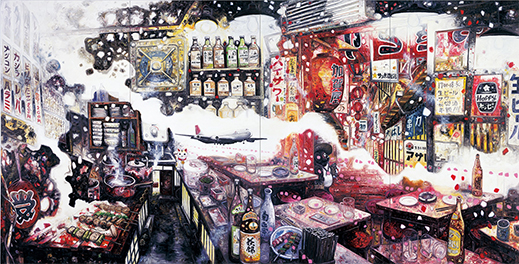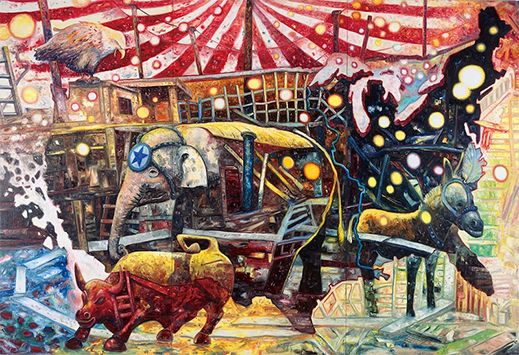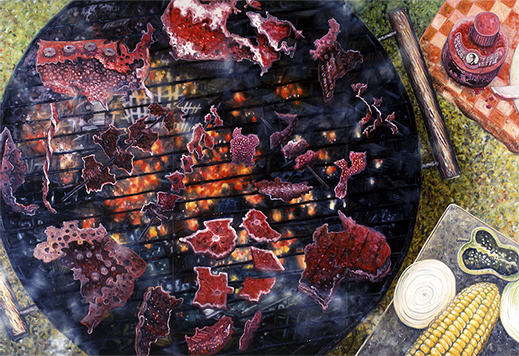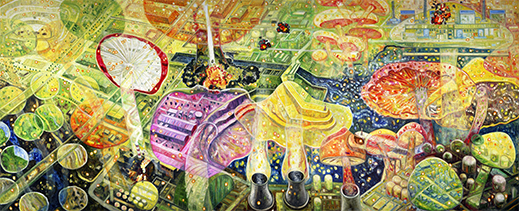 |
|
Here and There introduces art, artists, galleries and museums around Japan that non-Japanese readers and first-time visitors may find of particular interest. The writer claims no art expertise, just a subjective viewpoint acquired over many years' residence in Japan.
|
|
 |
|
|
 |
 |
A Little Light on the Subject: Oscar Oiwa in Kanazawa
Alan Gleason |
 |
 |
|
Journey to the Light, the Oscar Oiwa retrospective currently at the 21st Century Museum of Contemporary Art, Kanazawa, presents a body of work that manages to be both thought-provoking and visually appealing. His oil paintings are big, bright, and full of figurative and abstract elements in just the right proportion to catch the eye while not perplexing it. Oiwa is above all a symbolist who paints allegorical commentaries on the state of the world as he sees it. Scrutinizing contemporary society in all its contradictions, he sometimes finds it appalling, sometimes delightful, sometimes simply bemusing.
 |
|
By dint of his Japanese ancestry, and the fact that he lived for several years in Tokyo, Oiwa enjoys a certain cachet in Japan as "one of our own" in the manner of Isamu Noguchi or Naomi Osaka. Yet his art sparkles with a decidedly un-Japanese joie de vivre -- and a dollop of magical realism -- more readily associated with Brazil, his birthplace, and Latin American art in general. A son of São Paulo, Oiwa has spent most of his life in that city, Tokyo, and New York, his current base of operations. Each of these far-flung megalopolises can lay claim to being a source of his creative inspiration.
 |
|
 |
|
Big Circus, 2011 (top); Meat Market (Eating), 2005 (bottom) |
His color-saturated palette may thus be placed in the service of a work like Big Circus, a statement about American politics today that has a Republican elephant, a Democratic donkey, and the Wall Street bull cavorting through a map of the United States (an eagle looks stoically on); or Meat Market, in which chunks of red meat cut in the shapes of various countries sizzle on a New York Chinatown grill; or Kita-Senju, a rollicking ode to the funky Tokyo neighborhood where he lived in his twenties -- a montage of back alleys, bar signs, liquor bottles and, tucked nearly out of sight, his tiny apartment; or Journey to the Light, a glorious yellow-green study of woods suffused with white particles emanating from a blazing light source beyond the trees that might or might not be the sun.
Journey to the Light, 2018 |
Oiwa's symbolism is often self-evident, but not always so. He enjoys playing with certain whimsical motifs which by themselves are hard to parse, though not unpleasing to look at. The stylized rabbit and cat figures that recur in a number of works are an example. In the text accompanying this show, Oiwa is happy to explain what these mean to him: "Light Rabbit" is inspired by rabbits he saw racing across a runway at Charles de Gaulle Airport, and its dark counterpart, "Shadow Cat," by the stray cats of his Tokyo neighborhood. A recent series of New York cityscapes are painted over with swirling white patterns that, Oiwa says, represent the electromagnetic waves of the World Wide Web that cover us today like an invisible, infinite net.
World Wide Web Wave 2 (Wall Street), 2017 |
Even before he began painting the Internet into his pictures, Oiwa was sprinkling them with a different kind of seasoning: snowflake-like particles of varying colors that defy identification. In her exhibition catalog essay "When the Light Meets the Dark," curator Yukiko Yokoyama avers that these are particles of light itself, but as often as not they seem more like dust motes, raindrops, pollen, or perhaps an abstract disintegration of the picture plane. Artscape's own Christopher Stephens, who translated much of the catalog, has a slightly different take, seeing them as "a reminder that the air is filled with all sorts of particles with varying degrees of visibility and toxicity. They are calming and attractive but at the same time ominous and worrying, and they add another layer of meaning and a physical dimension to the pictures."
 |
|
The association of these motes with pollution is a compelling one, given Oiwa's articulated concern with the damage we humans are doing to our environment. Mushroom Forest offers an aerial view of a nuclear power plant with giant candy-colored mushrooms soaring into the sky among the cooling towers. Despite their cheerful hues, the fungi look nothing if not malevolent, and the spore-like blobs that waft across the canvas accentuate the air of disease and decay.
 |
|
More recently, Oiwa says he has made a conscious effort to add a note of hope to his sometimes dire readings of what the future holds. His metaphor of choice is light, as Yokoyama rightly points out in her essay, and as exemplified by the exhibition's titular painting. However, the predominant tone of these works is not the white of the sun, but a vibrant blend of blues, yellows and greens, the colors of the Amazon rain forest. And indeed, trees and other dense vegetation are the primary motifs. Oiwa's whimsy is at its most impish here; in Five Nests, the avian habitats perched high in the trees contain tiny human furnishings -- sofas, hot tubs, even a desktop computer. Flecks of gold float in the air like blessings from heaven. Or perhaps they are simply dapplings of sunlight filtered through the forest canopy. In any event they fill the space with a mood of all-embracing benediction, as if Nature were planting a motherly kiss on our scabbed little souls that will make everything all right.
|
 |
|
|
|
Oscar Oiwa. Photo by Luna
|
This seems to be what Oiwa has in mind. His essay in the catalog concludes: "Recently, I decided that in order to become happy, it's important to cultivate the light I'm aiming for myself. It seems to me that happiness isn't something you get, it's something you make. Thinking that I'd like to give form to this abstract idea, I made a series of works with greens and blues that are overflowing with light."
Oiwa may be on to something, because it's unlikely you will walk out of this show without an extra spring in your step.
All works shown are by Oscar Oiwa; all images are courtesy of the 21st Century Museum of Contemporary Art, Kanazawa. |
 |
| Oscar Oiwa: Journey to the Light |
| 27 April - 25 August 2019 |
| 21st Century Museum of Contemporary Art, Kanazawa |
1-2-1 Hirosaka, Kanazawa City, Ishikawa Prefecture
Phone: 076-220-2800
Exhibition Zone: 10:00 a.m. to 6:00 p.m. (8:00 p.m. on Friday and Saturday); closed Monday (or the following weekday when Monday is a national holiday)
Public Zone: 9 a.m. to 10 p.m. daily
(Both zones are closed during the New Year holidays.)
Access: The museum is in Kanazawa's downtown Korinbo district, 10 minutes by bus from JR Kanazawa Station. Kanazawa is 2 1/2 hours by train from Tokyo on the Hokuriku Shinkansen Line.
|
|
|
|
| |
 |
Alan Gleason
Alan Gleason is a translator, editor and writer based in Tokyo, where he has lived for over 30 years. In addition to writing about the Japanese art scene he has edited and translated works on Japanese theater (from kabuki to the avant-garde) and music (both traditional and contemporary). |
|
|
|
|
|
|
|
|
|
 |
|